Longitudinal Association of Economic Growth with Lung Function of Chinese Children and Adolescents over 30 Years: Evidence from Seven Successive National Surveys
Abstract
1. Introduction
2. Methods
2.1. Study Design and Participants
2.2. Measurement
2.3. Statistical Analysis
3. Results
3.1. Trends Results
3.2. Linear Analysis
3.3. Quadratic Analysis
3.4. Periodical Analysis
4. Discussion
5. Conclusions
Author Contributions
Funding
Institutional Review Board Statement
Informed Consent Statement
Data Availability Statement
Acknowledgments
Conflicts of Interest
Appendix A
Appendix B
| LFVC | |||||||||
|---|---|---|---|---|---|---|---|---|---|
| Urban Boys | Urban Girls | Rural Boys | Rural Girls | ||||||
| Models | Variable | β | p Values | β | p Values | β | p Values | β | p Values |
| Linear | DLGDPPC | −0.13 (−5.12) | 0.000 | −0.16 (−5.66) | 0.000 | 0.02 (1.03) | 0.305 | −0.02 (0.76) | 0.450 |
| Quadratic | DLGDPPC | −41.43 (−16.39) | 0.000 | −53.19 (−20.52) | 0.000 | −30.46 (−14.39) | 0.000 | −43.21 (−18.00) | 0.000 |
| DLGDPPC^2 | 27.42 (16.43) | 0.000 | 35.22 (20.57) | 0.000 | 20.24 (14.47) | 0.000 | 28.70 (18.08) | 0.000 | |
Appendix C
| LFVC | ||||||||
|---|---|---|---|---|---|---|---|---|
| Urban Boys | Urban Girls | Rural Boys | Rural Girls | |||||
| Variable | Linear | Quadratic | Linear | Quadratic | Linear | Quadratic | Linear | Quadratic |
| LGDPPC | −0.022 *** | −0.787 *** | −0.039 *** | −0.938 *** | −0.033*** | −0.490 *** | −0.057 *** | −0.673 *** |
| (−7.60) | (−17.33) | (−14.88) | (−19.46) | (−11.12) | (−9.81) | (−24.32) | (−14.38) | |
| LGDPPC^2 | 0.053 *** | 0.062 *** | 0.031 *** | 0.042 *** | ||||
| (16.71) | (18.45) | (9.04) | (13.06) | |||||
| Observations | 3024 | 3024 | 3024 | 3024 | 3024 | 3024 | 3024 | 3024 |
References
- da Silva, B.G.; Menezes, A.M.; Wehrmeister, F.C.; Barros, F.C.; Pratt, M. Screen-based sedentary behavior during adolescence and pulmonary function in a birth cohort. Int. J. Behav. Nutr. Phys. Act. 2017, 14, 1–8. [Google Scholar] [CrossRef] [PubMed]
- Knuiman, M.; James, A.L.; Divitini, M.L.; Ryan, G.; Bartholomew, H.C.; Musk, A. Lung Function, Respiratory Symptoms, and Mortality: Results from the Busselton Health Study. Ann. Epidemiol. 1999, 9, 297–306. [Google Scholar] [CrossRef]
- Mathers, C.D.; Loncar, D. Projections of global mortality and burden of disease from 2002 to 2030. PLoS Med. 2006, 3, e442. [Google Scholar] [CrossRef] [PubMed]
- Badaam Khaled, M.; Munibuddin, A.; Khan, S.T.; Choudhari, S.P.; Doiphode, R. Effect of traditional aerobic exercises versus sprint interval training on pulmonary function tests in young sedentary males: A randomised controlled trial. J. Clin. Diagn. Res. JCDR 2013, 7, 1890–1893. [Google Scholar]
- Lum, S.; Stocks, J. Forced expiratory manoeuvres. Paediatr. Lung Funct. 2010, 46–65. [Google Scholar] [CrossRef]
- Quanjer, P.H. Lung function, race and ethnicity: A conundrum. Eur. Respir. J. 2013, 41, 1249–1251. [Google Scholar] [CrossRef]
- Harik-Khan, R.I.; Muller, D.C.; Wise, R.A. Racial Difference in Lung Function in African-American and White Children: Effect of Anthropometric, Socioeconomic, Nutritional, and Environmental Factors. Am. J. Epidemiol. 2004, 160, 893–900. [Google Scholar] [CrossRef]
- Peeters, G.M.E.E.; Burton, N.W.; Brown, W.J. Associations between sitting time and a range of symptoms in mid-age women. Prev. Med. 2013, 56, 135–141. [Google Scholar] [CrossRef]
- Rocha, V.; Soares, S.; Stringhini, S.; Fraga, S. Socioeconomic circumstances and respiratory function from childhood to early adulthood: A systematic review and meta-analysis. BMJ Open 2019, 9, e027528. [Google Scholar] [CrossRef]
- Da Silva, B.G.; Wehrmeister, F.C.; Quanjer, P.H.; Pérez-Padilla, R.; Gonçalves, H.; Horta, B.L.; Hallal, P.C.; Barros, F.; Menezes, A.M. Physical activity in early adolescence and pulmonary function gain from 15 to 18 years of age in a birth cohort in Brazil. J. Phys. Act. Health 2016, 13, 1164–1173. [Google Scholar] [CrossRef][Green Version]
- Gaffney, A.W.; Hang, J.-Q.; Lee, M.-S.; Su, L.; Zhang, F.-Y.; Christiani, D.C. Socioeconomic status is associated with reduced lung function in China: An analysis from a large cross-sectional study in Shanghai. BMC Public Health 2015, 16, 96. [Google Scholar] [CrossRef] [PubMed]
- Menezes, A.M.B.; Dumith, S.C.; Perez-Padilla, R.; Noal, R.B.; Wehrmeister, F.C.; Martínez-Mesa, J.; Araújo, C.L.P.; Hallal, P.C. Socioeconomic trajectory from birth to adolescence and lung function: Prospective birth cohort study. BMC Public Health 2011, 11, 596–597. [Google Scholar] [CrossRef]
- Gong, P.; Liang, S.; Carlton, E.J.; Jiang, Q.; Wu, J.; Wang, L.; Remais, J.V. Urbanisation and health in China. Lancet 2012, 379, 843–852. [Google Scholar] [CrossRef]
- Yang, G.; Wang, Y.; Zeng, Y.; Gao, G.F.; Liang, X.; Zhou, M.; Wan, X.; Yu, S.; Jiang, Y.; Naghavi, M.; et al. Rapid health transition in China, 1990–2010: Findings from the Global Burden of Disease Study 2010. Lancet 2013, 381, 1987–2015. [Google Scholar] [CrossRef]
- Dong, Y.; Lau, P.W.; Dong, B.; Zou, Z.; Yang, Y.; Wen, B.; Ma, Y.; Hu, P.; Song, Y.; Ma, J.; et al. Trends in physical fitness, growth, and nutritional status of Chinese children and adolescents: A retrospec-tive analysis of 1.5 million students from six successive national surveys between 1985 and 2014. Lancet Child Adolesc. Health 2019, 3, 871–880. [Google Scholar] [CrossRef]
- Kuznets, S. Economic growth and income inequality. Am. Econ. Rev. 1955, 45, 1–28. [Google Scholar]
- Costa-Font, J.; Hernandez-Quevedo, C.; Sato, A. A Health ‘Kuznets’ Curve’? Cross-Sectional and Longitudinal Evidence on Concentration Indices. Soc. Indic. Res. 2018, 136, 439–452. [Google Scholar] [CrossRef]
- Grecu, A.M.; Rotthoff, K.W. Economic growth and obesity: Findings of an Obesity Kuznets curve. Appl. Econ. Lett. 2014, 22, 539–543. [Google Scholar] [CrossRef]
- Windarti, N.; Hlaing, S.; Kakinaka, M. Obesity Kuznets curve: International evidence. Public Health 2019, 169, 26–35. [Google Scholar] [CrossRef] [PubMed]
- Gan, X.; Wen, X.; Lu, Y.; Yu, K. Economic Growth and Cardiorespiratory Fitness of Children and Adolescents in Urban Areas: A Panel Data Analysis of 27 Provinces in China, 1985-2014. Int. J. Environ. Res. Public Health 2019, 16, 3772. [Google Scholar] [CrossRef]
- Godfrey, M.S.; Jankowich, M.D. The Vital Capacity Is Vital Epidemiology and Clinical Significance of the Restrictive Spirometry Pattern. Chest 2016, 149, 238–251. [Google Scholar] [CrossRef]
- Wooldridge, J.M. Econometric Analysis of Cross Section and Panel Data; MIT Press: Cambridge, UK, 2010. [Google Scholar]
- Haans, R.F.J.; Pieters, C.; He, Z.-L. Thinking about U: Theorizing and testing U- and inverted U-shaped relationships in strategy research. Strat. Manag. J. 2016, 37, 1177–1195. [Google Scholar] [CrossRef]
- Jackson, B.; Kubzansky, L.D.; Cohen, S.; Weiss, S.; Wright, R.J. A matter of life and breath: Childhood socioeconomic status is related to young adult pulmonary function in the CARDIA study. Int. J. Epidemiol. 2004, 33, 271–278. [Google Scholar] [CrossRef] [PubMed]
- Taylor-Robinson, D.C.; Smyth, R.L.; Diggle, P.; Whitehead, M. The effect of social deprivation on clinical outcomes and the use of treatments in the UK cystic fibrosis population: A longitudinal study. Lancet Respir. Med. 2013, 1, 121–128. [Google Scholar] [CrossRef]
- Galobardes, B.; Granell, R.; Sterne, J.; Hughes, R.; Mejia-Lancheros, C.; Davey Smith, G.; Henderson, J. Childhood Wheezing, Asthma, Allergy, Atopy, and Lung Function: Different Socioeconomic Patterns for Different Phenotypes. Am. J. Epidemiol. 2015, 182, 763–774. [Google Scholar] [CrossRef]
- Tennant, P.W.; Gibson, G.J.; Parker, L.; Pearce, M.S.; Msc, P.W.G.T. Childhood Respiratory Illness and Lung Function at Ages 14 and 50 Years: Childhood Respiratory Illness and Lung Function. Chest 2010, 137, 146–155. [Google Scholar] [CrossRef] [PubMed]
- Wu, Y.-F.; Wu, C.-K.; Chen, D.-R.; Chie, W.-C.; Lee, Y.L. Association of area socioeconomic status with lung function in children. Prev. Med. 2012, 55, 644–649. [Google Scholar] [CrossRef]
- Yuan, J.; Lu, Y.; Ferrier, R.C.; Liu, Z.; Su, H.; Meng, J.; Song, S.; Jenkins, A. Urbanization, rural development and environmental health in China. Environ. Dev. 2018, 28, 101–110. [Google Scholar] [CrossRef]
- Sarkar, C.; Zhang, B.; Ni, M.; Kumari, S.; Bauermeister, S.; Gallacher, J.; Webster, C. Environmental correlates of chronic obstructive pulmonary disease in 96779 participants from the UK Bi-obank: A cross-sectional, observational study. Lancet Planet. Health 2019, 3, e478–e490. [Google Scholar] [CrossRef]
- Urman, R.; McConnell, R.; Islam, T.; Avol, E.L.; Lurmann, F.W.; Vora, H.; Linn, W.S.; Rappaport, E.B.; Gilliland, F.D.; Gauderman, W.J. Associations of children’s lung function with ambient air pollution: Joint effects of regional and near-roadway pollutants. Thorax 2014, 69, 540–547. [Google Scholar] [CrossRef]
- Liu, S.; Zhou, Y.; Liu, S.; Chen, X.; Zou, W.; Zhao, D.; Li, X.; Pu, J.; Huang, L.; Chen, J.; et al. Association between exposure to ambient particulate matter and chronic obstructive pulmonary disease: Results from a cross-sectional study in China. Thorax 2017, 72, 788–795. [Google Scholar] [CrossRef]
- Simões, R.P.; Deus, A.P.; Auad, M.A.; Dionísio, J.; Mazzonetto, M.; Borghi-Silva, A. Maximal respiratory pressure in healthy 20 to 89 year-old sedentary individuals of central São Paulo State. Braz. J. Phys. Ther. 2010, 14, 60–67. [Google Scholar] [CrossRef]
- Li, J.; Luo, Y.; Wang, S. Spatial effects of economic performance on the carbon intensity of human well-being: The environmental Kuznets curve in Chinese provinces. J. Clean. Prod. 2019, 233, 681–694. [Google Scholar] [CrossRef]
- Xie, S.; Wang, T.; Liu, S.; Jones, K.C.; Sweetman, A.J.; Lu, Y. Industrial source identification and emission estimation of perfluorooctane sulfonate in China. Environ. Int. 2013, 52, 1–8. [Google Scholar] [CrossRef]
- Khashaba, A.S. Effect of Levels of Physical Activity on Pulmonary Function of Male Saudi University Students. Int. J. Sports Sci. 2015, 5, 209–212. [Google Scholar]
- Shaheen, S.O.; Jameson, K.A.; Syddall, H.E.; Sayer, A.A.; Dennison, E.M.; Cooper, C.; Robinson, S.M.; The Hertfordshire Cohort Study Group. The relationship of dietary patterns with adult lung function and COPD. Eur. Respir. J. 2010, 36, 277–284. [Google Scholar] [CrossRef]
- Sonnappa, S.; Lum, S.; Kirkby, J.; Bonner, R.; Wade, A.; Subramanya, V.; Lakshman, P.T.; Rajan, B.; Nooyi, S.C.; Stocks, J. Disparities in pulmonary function in healthy children across the Indian urban-rural continuum. Am. J. Respir. Crit. Care Med. 2015, 191, 79–86. [Google Scholar] [CrossRef]
- Stocks, J.; Hislop, A.; Sonnappa, S. Early lung development: Lifelong effect on respiratory health and disease. Lancet Respir. Med. 2013, 1, 728–742. [Google Scholar] [CrossRef]
- Quon, E.C.; McGrath, J.J. Province-Level Income Inequality and Health Outcomes in Canadian Adolescents. J. Pediatr. Psychol. 2014, 40, 251–261. [Google Scholar] [CrossRef] [PubMed]
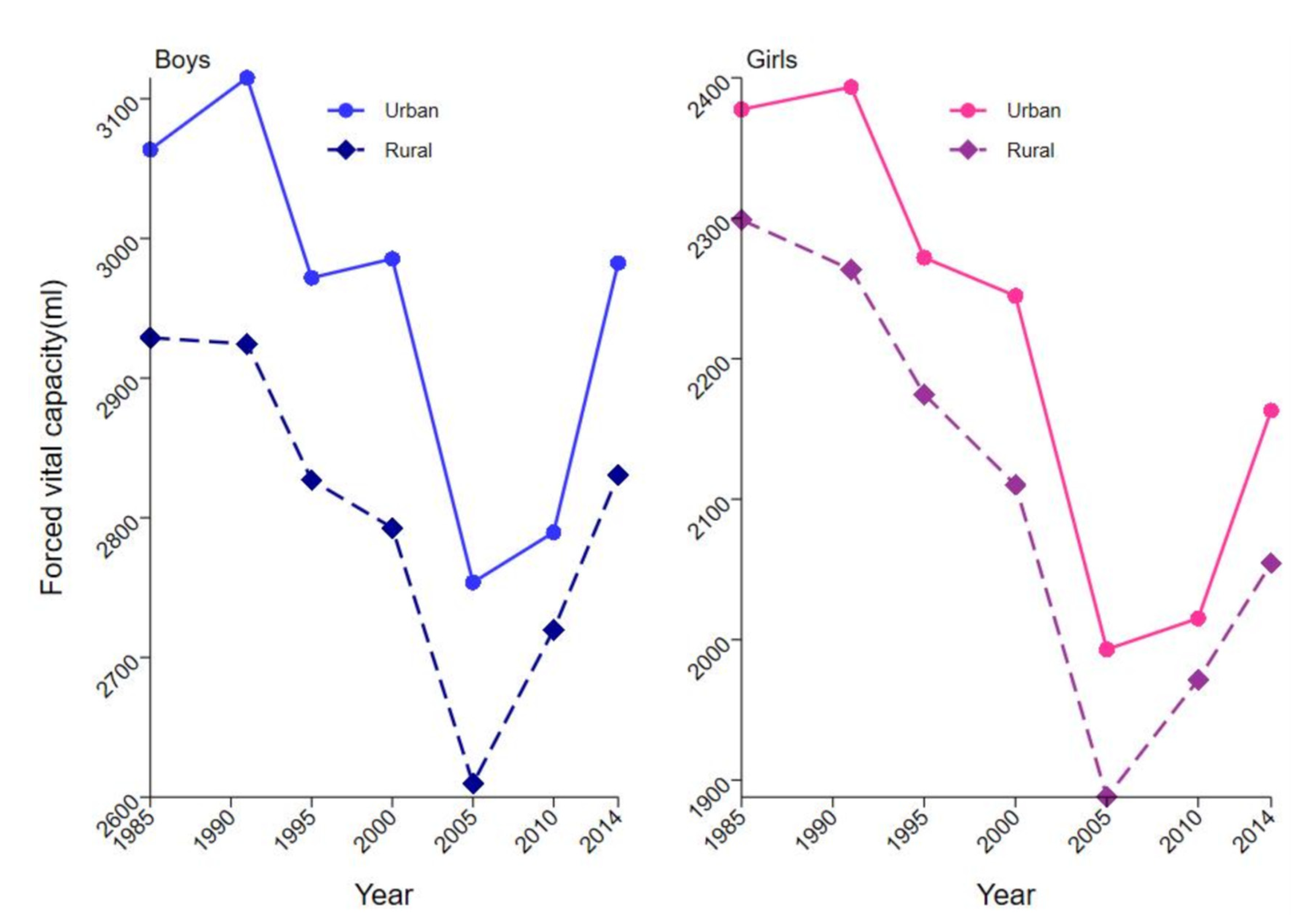
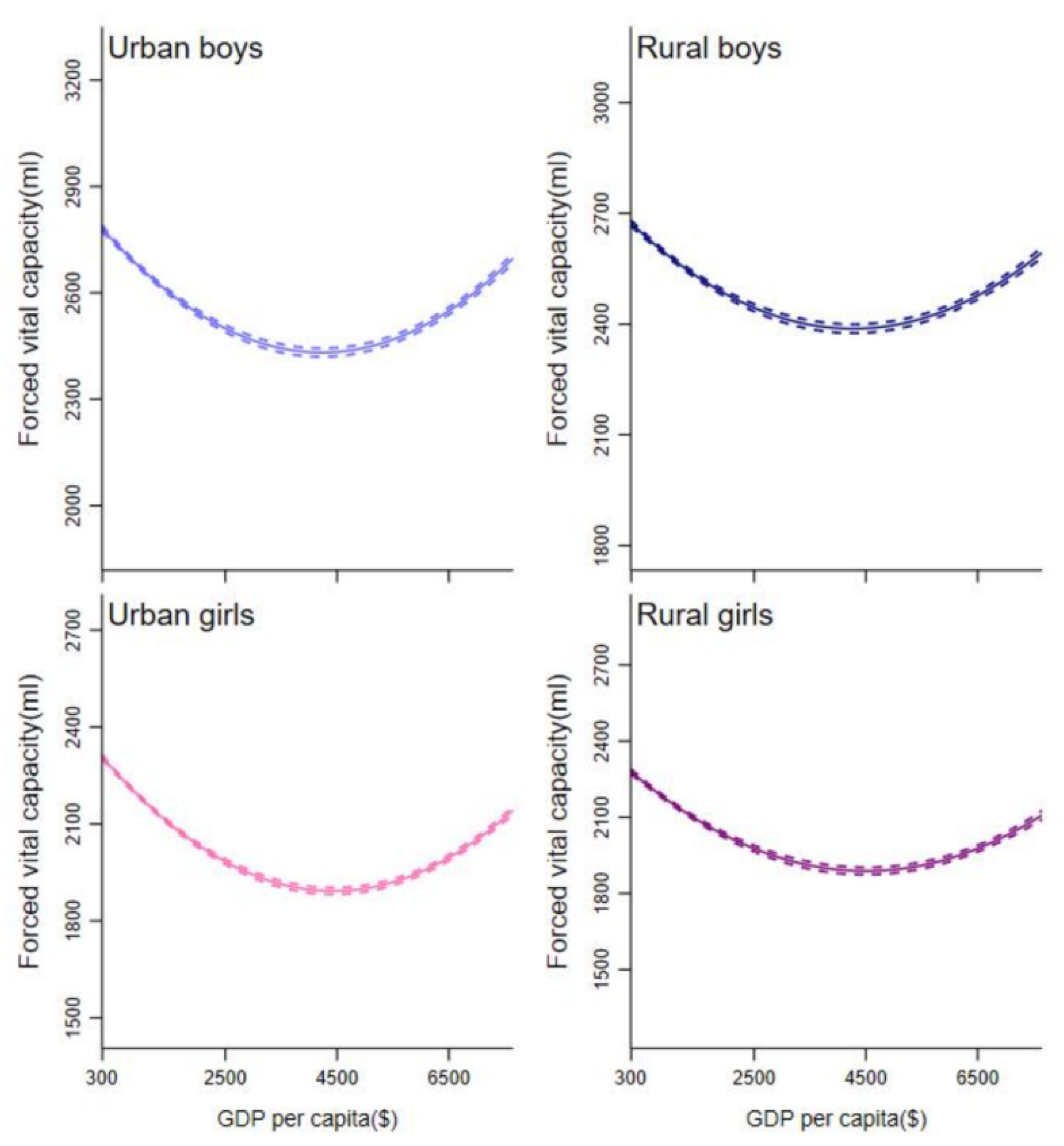
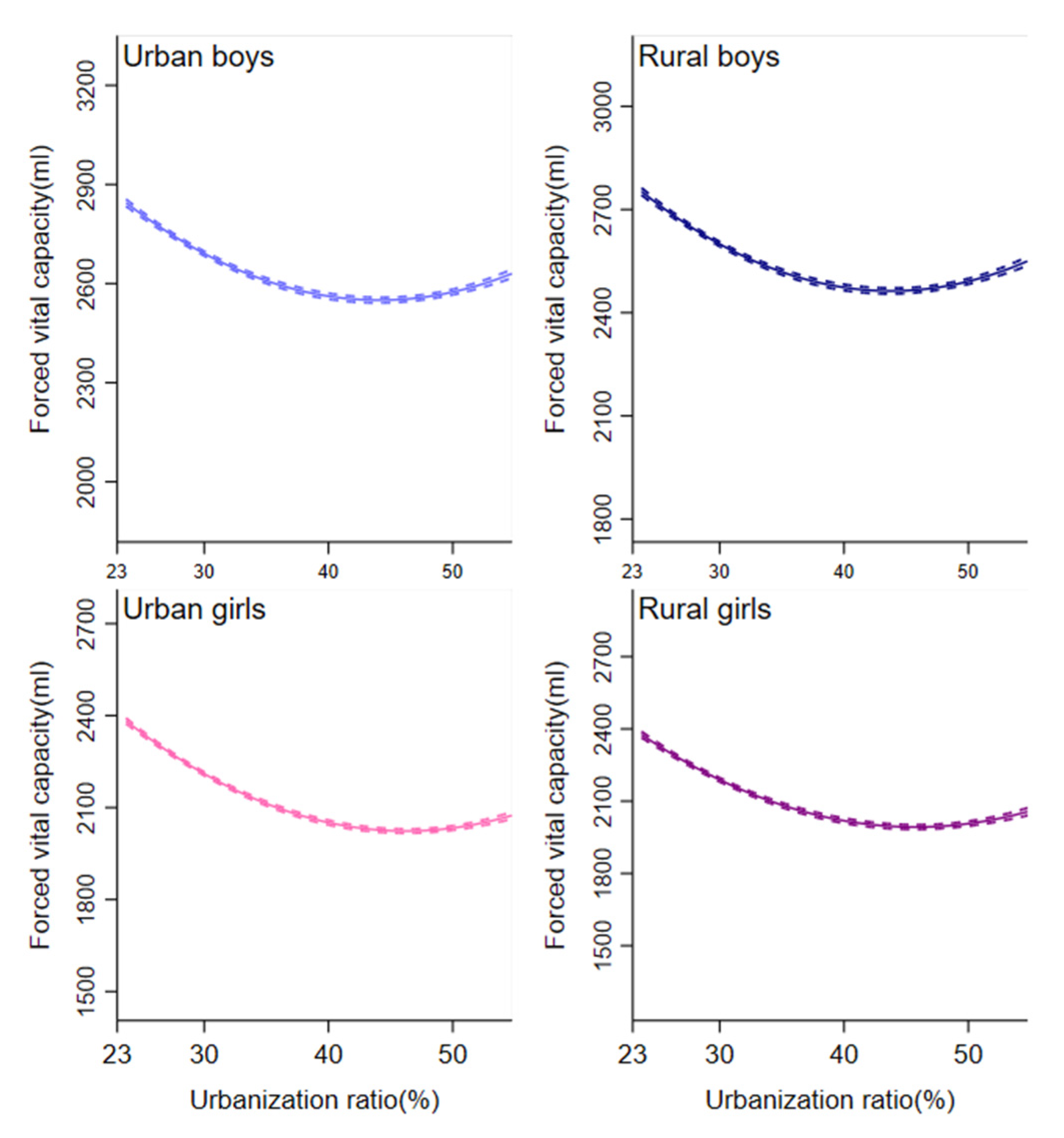
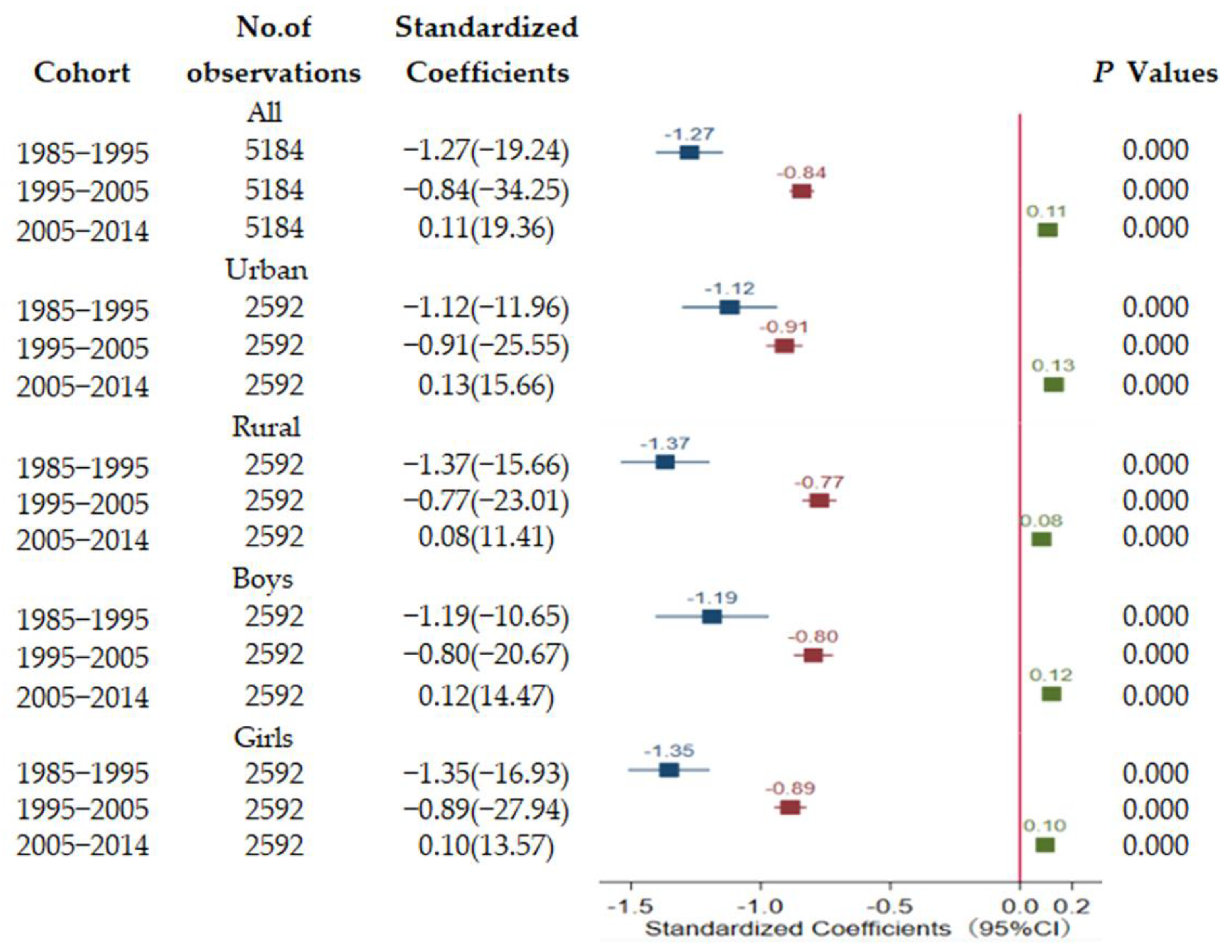
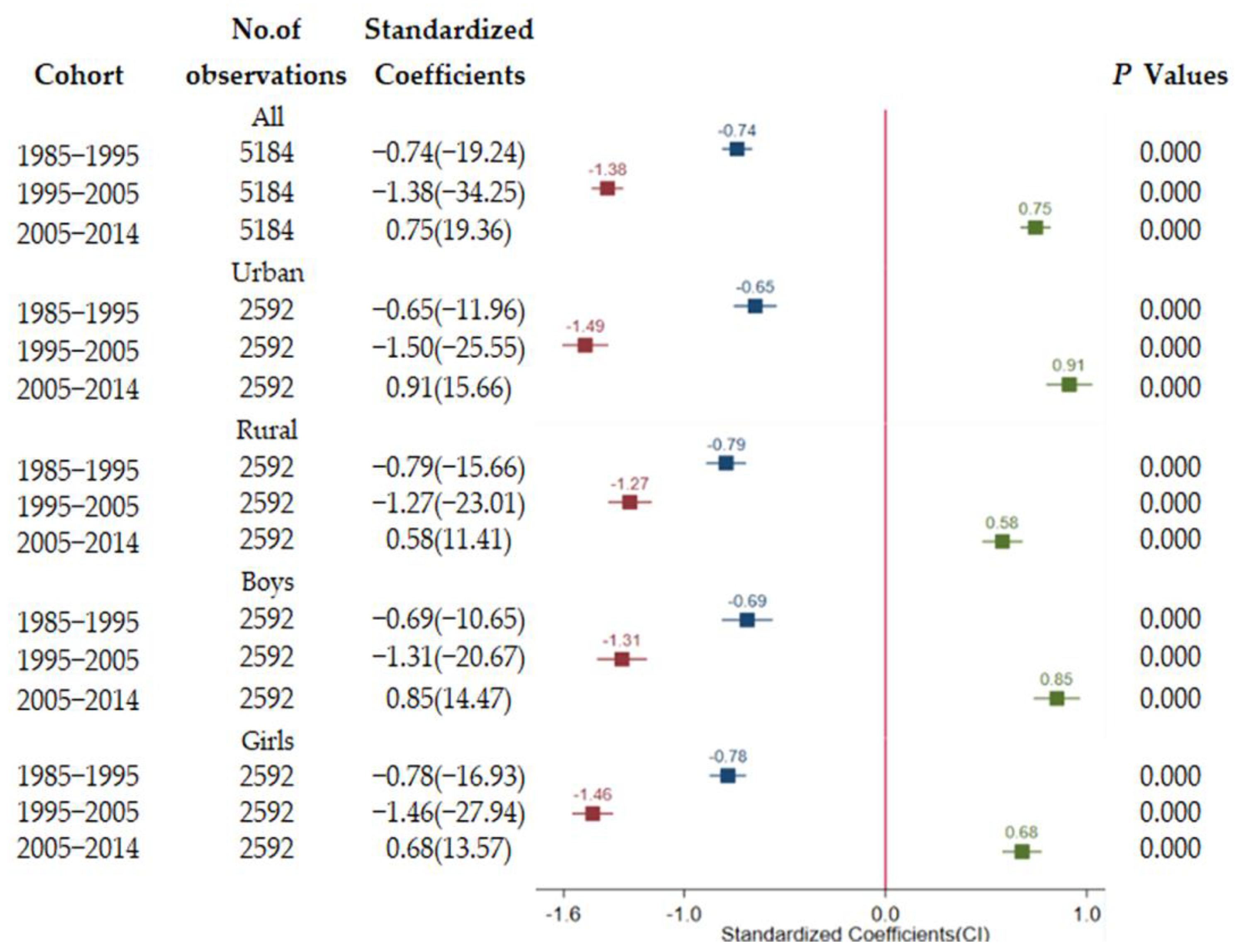
| 1985 | 1991 | 1995 | 2000 | 2005 | 2010 | 2014 | |
|---|---|---|---|---|---|---|---|
| Sample size | 409,836 | 184,835 | 204,763 | 216,073 | 234,289 | 215,223 | 214,301 |
| Setting | |||||||
| Urban | 204,669 (49.9%) | 93,545 (50.6%) | 103,674 (50.6%) | 108,564 (50.2%) | 117,932 (50.3%) | 107,537 (50.0%) | 107,211 (50.0%) |
| Rural | 205,167 (50.1%) | 91,290 (49.4%) | 101,089 (49.4%) | 107,509 (49.8%) | 116,357 (49.7%) | 107,686 (50.0%) | 107,090 (50.0%) |
| Sex | |||||||
| Boys | 205,040 (50.0%) | 93,587 (50.6%) | 102,998 (50.3%) | 107,985 (50.0%) | 117,594 (50.2%) | 107,611 (50.0%) | 107,175 (50.0%) |
| Girls | 204,796 (50.0%) | 91,248 (49.4%) | 101,765 (49.7%) | 108,088 (50.0%) | 116,695 (49.8%) | 107,612 (50.0%) | 107,126 (50.0%) |
| FVC (mL) | |||||||
| Male (urban) | 3063.6 (1077.1) | 3115.0 (1046.4) | 2971.7 (1012.5) | 2985.4 (1012.2) | 2753.7 (1022.7) | 2789.6 (1055.7) | 2982.3 (1077.3) |
| Female (urban) | 2377.4 (594.9) | 2393.4 (564.8) | 2271.9 (567.3) | 2244.7 (553.6) | 1993.0 (547.4) | 2015.1 (569.2) | 2163.1 (573.2) |
| Male (rural) | 2928.9 (1082.7) | 2924.5 (1076.6) | 2826.9 (1020.2) | 2792.8 (1008.6) | 2609.7 (1006.4) | 2719.7 (1049.9) | 2830.4 (1063.9) |
| Female (rural) | 2298.8 (632.5) | 2263.3 (596.1) | 2174.6 (600.2) | 2110.2 (563.7) | 1887.9 (551.1) | 1971.3 (560.5) | 2054.2 (572.4) |
| Height (cm) | |||||||
| Male (urban) | 154.1 (17.6) | 156.0 (16.6) | 156.6 (16.7) | 157.5 (16.6) | 158.4 (16.3) | 159.4 (16.1) | 160.3 (15.8) |
| Female (urban) | 148.7 (13.1) | 150.2 (12.3) | 150.4 (12.2) | 151.0 (12.2) | 151.7 (11.9) | 152.5 (11.6) | 153.1 (11.3) |
| Male (rural) | 150.4 (18.0) | 152.5 (17.4) | 153.2 (17.2) | 154.1 (17.3) | 155.5 (16.8) | 156.5 (16.6) | 158.1 (16.3) |
| Female (rural) | 145.4 (13.9) | 146.9 (13.2) | 147.7 (12.9) | 148.3 (12.9) | 149.3 (12.4) | 150.5 (12.5) | 151.3 (11.8) |
| Weight (kg) | |||||||
| Male (urban) | 43.5 (13.6) | 45.8 (13.2) | 47.0 (13.5) | 49.1 (14.0) | 50.5 (13.5) | 52.0 (13.7) | 53.7 (13.9) |
| Female (urban) | 40.2 (10.7) | 41.4 (10.1) | 42.3 (10.3) | 43.4 (10.3) | 44.1 (9.9) | 44.9 (9.7) | 46.2 (9.8) |
| Male (rural) | 41.9 (13.9) | 43.3 (13.8) | 44.1 (13.8) | 45.1 (13.9) | 46.5 (13.5) | 48.2 (13.6) | 50.6 (13.6) |
| Female (rural) | 39.6 (11.6) | 40.2 (11.1) | 41.0 (11.1) | 41.4 (11.0) | 42.1 (10.4) | 43.4 (10.4) | 44.5 (9.9) |
| GDP per capita (US$) | 280 | 341 | 519 | 939 | 1669 | 4295 | 7529 |
| Urbanization ratio | 23.7% | 26.4% | 29% | 36.2% | 43.0% | 48.0% | 54.8% |
| LFVC | |||||||||
|---|---|---|---|---|---|---|---|---|---|
| Urban Boys | Urban Girls | Rural Boys | Rural Girls | ||||||
| Models | Variable | β | p Values | β | p Values | β | p Values | β | p Values |
| Linear | LGDPPC | −0.02 (−6.75) | 0.000 | −0.04 (−14.08) | 0.000 | −0.03 (−11.38) | 0.000 | −0.06 (−21.38) | 0.000 |
| Quadratic | LGDPPC | −0.78 (−17.08) | 0.000 | −0.94 (−18.57) | 0.000 | −0.49 (−11.26) | 0.000 | −0.67 (−13.93) | 0.000 |
| LGDPPC^2 | 0.05 (16.57) | 0.000 | 0.06 (17.62) | 0.000 | 0.03 (10.50) | 0.000 | 0.04 (12.68) | 0.000 | |
| τ = 1669 | τ = 1919 | τ = 2921 | τ = 2697 | ||||||
| Linear | LURBAN | −0.09 (−6.75) | 0.000 | −0.15 (−14.08) | 0.000 | −0.12 (−11.38) | 0.000 | −0.22 (−21.38) | 0.000 |
| Quadratic | LURBAN | −5.91 (−16.84) | 0.000 | −7.00 (−18.10) | 0.000 | −3.61 (−10.88) | 0.000 | −4.92 (−13.31) | 0.000 |
| LURBAN^2 | 0.81 (16.57) | 0.000 | 0.96 (17.61) | 0.000 | 0.49 (10.49) | 0.000 | 0.66 (12.66) | 0.000 | |
| τ = 42.94 | τ = 42.09 | τ = 44.70 | τ = 50.90 | ||||||
Publisher’s Note: MDPI stays neutral with regard to jurisdictional claims in published maps and institutional affiliations. |
© 2021 by the authors. Licensee MDPI, Basel, Switzerland. This article is an open access article distributed under the terms and conditions of the Creative Commons Attribution (CC BY) license (https://creativecommons.org/licenses/by/4.0/).
Share and Cite
Gan, X.; Yu, K.; Wen, X.; Lu, Y. Longitudinal Association of Economic Growth with Lung Function of Chinese Children and Adolescents over 30 Years: Evidence from Seven Successive National Surveys. Int. J. Environ. Res. Public Health 2021, 18, 6592. https://doi.org/10.3390/ijerph18126592
Gan X, Yu K, Wen X, Lu Y. Longitudinal Association of Economic Growth with Lung Function of Chinese Children and Adolescents over 30 Years: Evidence from Seven Successive National Surveys. International Journal of Environmental Research and Public Health. 2021; 18(12):6592. https://doi.org/10.3390/ijerph18126592
Chicago/Turabian StyleGan, Xiaomei, Kehong Yu, Xu Wen, and Yijuan Lu. 2021. "Longitudinal Association of Economic Growth with Lung Function of Chinese Children and Adolescents over 30 Years: Evidence from Seven Successive National Surveys" International Journal of Environmental Research and Public Health 18, no. 12: 6592. https://doi.org/10.3390/ijerph18126592
APA StyleGan, X., Yu, K., Wen, X., & Lu, Y. (2021). Longitudinal Association of Economic Growth with Lung Function of Chinese Children and Adolescents over 30 Years: Evidence from Seven Successive National Surveys. International Journal of Environmental Research and Public Health, 18(12), 6592. https://doi.org/10.3390/ijerph18126592






